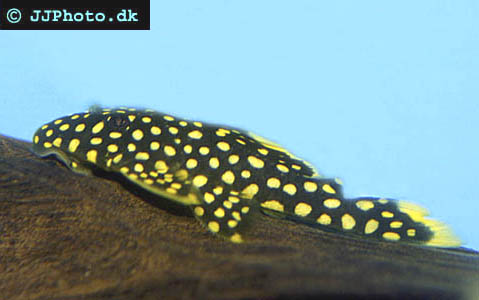Gold Nugget pleco and Mango pleco finally described by science
Two pleco species from the Xingu River drainage that are popular within the aquarium hobby have finally been scientifically described and given scientific names.
The fish known to aquarists as Gold Nugget pleco (L18, L85, L177) is from now on officially named Baryancistrus xanthellus, while the pleco called Mango pleco (L47) has been given the scientific name Baryancistrus chrysolomus.
The species were described and named by Lúcia Py-Daniel, Jansen Zuanon and Renildo de Oliveira in a paper published in the most recent issue of the journal Neotropical Ichthyology (http://www.scielo.br/scielo.php?pid=1679-6225&script=sci_serial).
Baryancistrus xanthellus (Golden Nugget pleco)
This is the pleco known to most aquarists as the Golden Nugget pleco, and it has been given three different L-numbers (L18, L85 and L177).
Baryancistrus xanthellus differs from other members of its genus by having a broad light band on the edges of the dorsal and caudal fin in juveniles, a band that turns into a small dot on the tips of these fins as the fish matures into an adult.
The body of Baryancistrus xanthellus is covered in pale spots. You can separate it from B. beggini by looking in its mouth; Baryancistrus xanthellus have more teeth in both the upper and lower jaw than B. beggini.
The authors found congregations of Baryancistrus xanthellus under flat rocks at the bottom in shallow parts of the Xingu River drainage where the water moved rapidly. They analyzed the stomach material and found out that it was chiefly algae.
Baryancistrus chrysolomus (Mango pleco)
This fish is known in the aquarium trade as Mango pleco and has the L-number L47. The scientific name, Baryancistrus chrysolomus, alludes to its yellow fin margins (chrysos and loma are the Greek words for yellow and border, respectively).
Just like B. xanthellus, Baryancistrus chrysolomus sports a broad orange to yellow band along the entire outer margin of the dorsal and caudal fins. This feature distinguishes B. xanthellus and B. chrysolomus from all other described members of the genus Baryancistrus.
To separate Baryancistrus chrysolomus from B. xanthellus, look for spots on the body. If there are no clear spots on the body, it is not a B. xanthellus.
The scientists encountered Baryancistrus chrysolomus under rocks at the bottom of the river in stretches where the water flow was slow to moderate. The fish fed by scraping algae from the rocks.
For more information on these two newly described species of pleco, see the paper: Py-Daniel, LR, J Zuanon and RR de Oliveira (2011) Two new ornamental loricariid catfishes of Baryancistrus from rio Xingu drainage (Siluriformes: Hypostominae). Neotropical Ichthyology 9, pp. 241–252.
